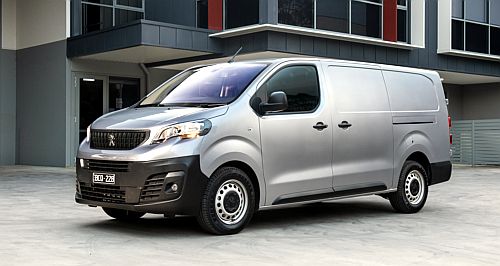News - Peugeot - Expert - EVMid-size e-Expert to join smaller e-PartnerPeugeot Australia says it is keen for more electric vans, with e-Expert on the radar18 Jul 2023 PEUGEOT Australia is keen to follow up this week’s launch of the battery electric e-Partner compact van with the mid-size e-Expert model.
According to Peugeot Australia national aftersales manager Kieran Gradidge, those wanting an electric van will not have to wait much longer for a larger Peugeot offering, with the e-Expert slated to arrive next year.
It will likely have a similar marketing strategy to its smaller e-Partner sibling in being sold alongside internal combustion engine variants when it launches Down Under some time in 2024 as a follow-up to an upcoming electric version of the 2008 small SUV and the return of the 208 light hatch in electric-only form.
After assessing the market, the fully electric e-Expert van got the go ahead for Australia, revealed Mr Gradidge.
“We will have more electric vehicles here soon starting with the e-2008 SUV and then the e-208 light car with electric LCVs in the pipeline,” he told GoAuto.
“The e-2008 is due before the end of the year and the e-208 will be here after that in 2024 and we are looking at getting the e-Expert mid-size van here in a similar time frame.”
In Australia, the e-Expert will have more competition than the smaller e-Partner, which has only one model against it at the moment: Renault’s ZE Kangoo.
The e-Expert will be up against fully electric models from Ford (E-Transit), Mercedes-Benz (eVito) and LDV (eDeliver 9) to name a few. Electric mid-size vans are expected from other brands including Volkswagen, Renault, Iveco, and a range of Chinese manufacturers.
Diesel versions of the Expert are priced from $43,397 plus on-road costs in Australia and, apart from the ageing Chinese-made LDV G10 and V80, is at the more affordable end of the segment at a snip less than VW’s Transporter kick-off price but around $7000 less than the Ford Transit, from $3000 less than the Hyundai Staria and from around $5500 less than the Renault Trafic starting point.
That pricing regime augurs well for the e-Expert, which could see it as one of the most affordable medium size BEV vans available here.
Peugeot Australia would be waiting for RHD availability of a mid-life e-Expert facelift to ensure the model was as up-to-date as possible for the local market.
The revised model’s appearance is reported to be updated along with other changes and inclusions putting a focus on the interior, a new digital dash, a large touchscreen and new steering wheel. The underfloor battery pack is reputedly upgraded for increased range and quicker charging.
Like the e-Partner, the e-Expert is based on Peugeot’s EMP2 platform, featuring a front-wheel drive configuration and a battery pack under the load space floor.
The model uses the same 100kW/260Nm single electric traction motor as the smaller e-Partner and is currently available overseas with a choice of 50- and 75kWh batteries, the latter capable of a claimed 330km WLTP range.
A segment up from the e-Partner, the e-Expert is sold in Europe in three sizes, Compact, Standard and Long wheelbase all offering the same payload weights and dimensions as the equivalent ICE models.
The larger van also boasts significantly greater towing and payloads at 1000kg and 1275kg respectively as opposed to the smaller van’s 750kg.
In relation to the demise of ICE powered LCVs, Peugeot Australia managing director Kate Gillis said the brand “won’t be turning away from ICE vehicles as we will continue to offer them alongside electric models going into the future”.
“Stellantis has parallel development programs on electric and ICE powertrains as it is committed to choice for all its customers.
“LCVs are an important part of our range, and we will look to provide more choice to our customers, many of whom want to downsize their vehicle or don’t want a ute,” she said.
Peugeot’s light commercials are popular in Europe, with strong sales across all powertrain types and size segments, and Peugeot Australia is keen to emulate the European LCV result here, leading to an expanded model line-up.
The French car-maker was among the first to introduce a light commercial van back in 1895 with the Peugeot Type 12. Essentially a motorised wagon, the vehicle had cut-through with buyers looking for a utilitarian carry-all.
The concept continued through the following 125 years with many more innovative LCV models such as the 163 model from the 1920s and the 1950s panel van, possibly the first of its kind.
That innovation is now focused on new energy vehicles (NEVs) including hydrogen but specifically those powered by electrified and fully electric drive trains.  Read more7th of July 2023  Peugeot E-208 Australia boundCompact 208 to return Down Under, this time with all-electric power1st of May 2023  Peugeot e-2008 here Q3 from $59,990French brand prices its small electric SUV ahead of third-quarter Aussie arrival29th of March 2023  Peugeot looks to electrified futureFrench brand’s product renewal cycle to introduce a raft of new PHEV and EV models |
Click to sharePeugeot articlesResearch Peugeot Expert pricing
Motor industry news |
















Facebook Twitter Instagram